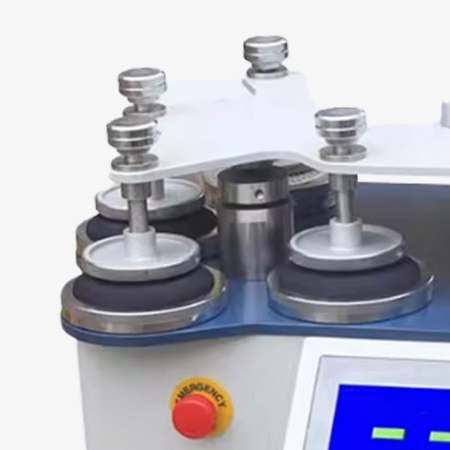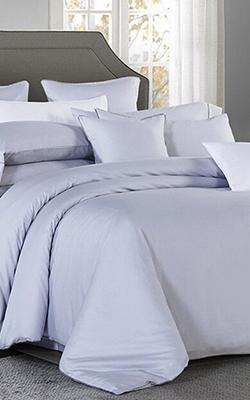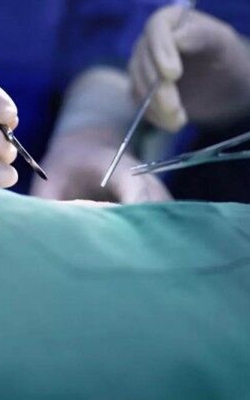The pilling tester has 8 stations, high efficiency, and adjustable weights of 100CN and 290CN. The touchscreen facilitates setting test parameters, and data can be saved and printed. The abrasion and pilling tester is widely used for testing fabric pilling and fuzzing in textile production, scientific research, testing, and home textile trade.

8 stations disc, high efficiency to test
- The digital pilling tester uses a circular motion to induce pilling or fuzzing on fabric samples, similar to everyday wear and friction.
- The friction disc pressure, rotation speed, and number of friction cycles can be adjusted to ensure repeatable and reliable pilling resistance test results.
- The friction disc can be covered with wool felt, sandpaper, or a standard friction cloth to simulate different friction environments.
- The fabric pilling tester's circular motion design ensures uniform force on the fabric during testing.
- The pilling tester machine has 8 stations, capable of testing multiple fabric samples at the same time with high efficiency and improved accuracy.

High precision touchscreen with optional weights
- The abrasion and pilling tester is equipped with a touchscreen display that displays test time, test count, and related parameters in real time, facilitating experimental management.
- The touchscreen interface allows for easy setting of test parameters and real-time monitoring of the pilling test in textile process. Automatic timing and counts are provided for easy operation, and test data can be saved or printed.
- The fuzzy pilling tester's transmission system ensures smooth, low-noise, and long-life operation of the friction disc.
- The pilling tester machine can be equipped with additional weights (100cN, 290cN) to adjust the pressure applied to the sample and simulate different levels of wear.
Application
The circular locaus pilling tester is a device specifically designed to evaluate the pilling properties of textiles. Fabric pilling testers can be widely used for fabric pilling tests on materials such as clothing, home textiles, automotive interior materials, and medical protective fabrics.

Household Textiles

Automotive Interior Textiles

Medical Protective Fabrics

Clothing
| Model | SISCO-PT-YG502-8 |
| Type | Circular locus pilling tester |
| Motion Trajectory | φ 40mm ± 1mm circular trajectory |
| Motion Speed | 60r/min ± 1r/min |
| Brush Height | Adjustable from 2mm to 10mm |
| Counting Range | 1 to 9999 |
| Dimension |
890×560×430mm |
| Power Supply | AC220V ± 10, 50Hz, 90W |
| Specimen Specifications | Circular shape with a diameter of 113mm |
| Weight | 43kg |
Q1: What is a pilling tester?
A1: The pilling tester is a specialized test device used to evaluate the degree of surface fuzzing and pilling of textiles (such as woven and knitted fabrics) under friction conditions. It quantifies the fabric's pilling resistance by simulating the friction experienced during daily wear or washing.
Q2: How does a fabric pilling tester work?
A2: The fabric pilling tester applies a specific pressure to the specimen, contacting it with a standard abrasive (such as a nylon brush, sandpaper, or cork backing). The mechanical motion creates friction, leading to fiber breakage, fuzzing, and ultimately, pilling. During the pilling stage, the fiber ends detach from the fabric surface due to friction, forming fuzz. During the pilling stage, the fuzz entangles into balls, some of which fall off due to continued friction.
Q3: What is the function of a pilling tester?
A3: The pilling tester machine simulates the frictional environment fabrics experience during wearing, washing, and daily use by applying friction, pressure, and motion. It also measures the fabric's resistance to pilling by detecting whether fibers on the surface tend to loosen, tangle, and form pills. The test results can guide the apparel, home textile, and other industries in selecting more durable fabrics, enhancing the comfort and lifespan of end products.
Tips: What is a circular locus pilling tester used for?
A circular track pilling tester is used to predict and measure the pilling resistance of fabrics under controlled laboratory conditions. A pilling tester machine is typically used to simulate abrasion and friction, assess fabric durability, and perform quality control and product development.
Thank you for buying industrial test and measurement equipment on SISCO.com, all products sold by SISCO and the partner cover a 12 months warranty, effective from the date of receiving the products.
What is covered?
SISCO is responsible for providing free spare parts, and free technical support to assist the customer to repair the defective products until the problem is solved.
What is not covered?
- Product purchased from anyone other than a SISCO store or a SISCO authorized reseller.
- Expendable parts.
- Routine cleaning or normal cosmetic and mechanical wear.
- Damage from misuse, abuse or neglect.
- Damage from use of parts other than SISCO approved.
- Damage from use outside the product’s usage or storage parameters.
- Damage from use of parts not sold by SISCO.
- Damage from modification or incorporation into other products.
- Damage from repair or replacement of warranted parts by a service provider other than a SISCO authorized service provider.
- Damage caused by the application environment not meeting the product usage requirements and the failure to perform preventive maintenance.

